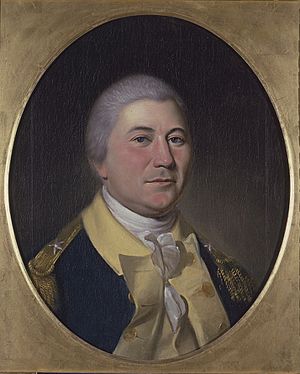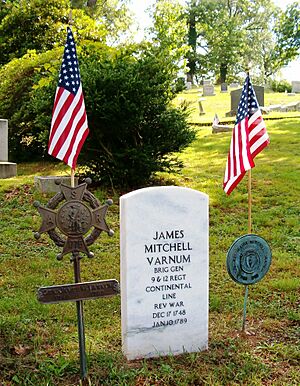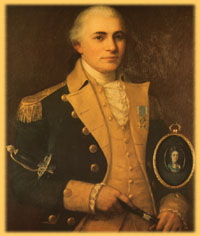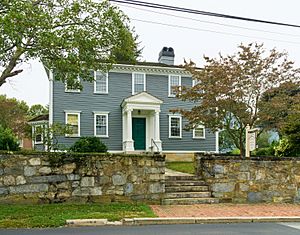James Mitchell Varnum facts for kids
Quick facts for kids
James Mitchell Varnum
|
|
|---|---|

James Mitchell Varnum, painted posthumously in 1804 by Charles Willson Peale
|
|
| Born | December 17, 1748 Dracut, Province of Massachusetts Bay |
| Died | January 9, 1789 (aged 40) Marietta, Ohio |
| Place of burial |
Oak Grove Cemetery, Marietta, Ohio
|
| Allegiance | |
| Service/ |
|
| Years of service | 1774–1779 |
| Rank |
|
| Battles/wars | |
| Other work | twice elected delegate to the Continental Congress (1780-82 and 1786-87), pioneer to the Ohio Country, justice of the Supreme Court of the Northwest Territory |
| Signature | |

James Mitchell Varnum (December 17, 1748 – January 9, 1789) was an important American leader. He was a general in the Continental Army during the American Revolutionary War. He also worked as a lawyer and a politician. Later, he became a pioneer, helping to settle new lands in what was called the Ohio Country.
Varnum was a very active person. He graduated from college at 20 and became a lawyer at 22. He joined the army at 27 and later became a member of Congress. He moved west at 39 and sadly passed away at the age of 40. He was also a member of the Society of the Cincinnati in Rhode Island.
Contents
Early Life and Education
James Mitchell Varnum was born in Dracut, Massachusetts. He first went to Harvard College. Later, he transferred to "Rhode Island College," which is now known as Brown University. He graduated with honors in 1769, as part of the college's very first graduating class.
In Rhode Island, he met Martha "Patty" Child. They got married on February 2, 1770. After college, James studied law with Oliver Arnold, who was the Attorney General of Rhode Island. He became a lawyer in 1771. He then moved to East Greenwich, Rhode Island, to start his law practice. In 1773, he began building his home, which is now a historic house called the Varnum House.
Leading in the American Revolution
In October 1774, tensions were growing between the American colonies and Great Britain. Varnum was chosen to be a captain in a new local army group called the Kentish Guards. This group was in his hometown of East Greenwich.
Another member of this group was Private Nathanael Greene. Greene would become a very important officer in the Continental Army. Many other members of the Kentish Guards also became officers in the army.
Joining the Continental Army
In May 1775, after the Battles of Lexington and Concord, Varnum became a colonel. He led one of Rhode Island's three regiments. These regiments were part of the "Army of Observation" during the Siege of Boston. In July 1775, General George Washington took command of this army, which then became the Continental Army.
In the early part of the war, regiments were often known by their leader's name. Varnum's Regiment was later renamed the 9th Continental Regiment in 1776.
Varnum's regiment helped during the Siege of Boston. This siege ended when the British army left Boston in March 1776. The regiment then marched to New York. They fought in battles like Long Island and White Plains. They tried to stop the British from taking over New York City, but they were not successful.
Becoming a General
In December 1776, Varnum went back to Rhode Island. He needed to find more soldiers for the army, as many soldiers' enlistment times were ending. On December 12, he became a brigadier general in the Rhode Island Militia. He led the state's army, protecting Rhode Island from possible British attacks. The British had recently taken over Newport.
Varnum did not stay in Rhode Island for long. In February 1777, he became a brigadier general in the Continental Army. He led a group of soldiers until he left the army in March 1779. During this time, he fought in the Red Bank in New Jersey in 1777. He also fought in the Battle of Rhode Island in 1778. He was with the army at Valley Forge during the very cold winter of 1777 to 1778.
Varnum believed that freed African American slaves should be allowed to join the Continental Army. Because of his efforts, the 1st Rhode Island Regiment became a unit with both Black and white soldiers in 1778.
Legal Work and Later Life
In March 1779, Varnum left the Continental Army because of his personal business. However, he became a major general in the Rhode Island Militia on May 10, 1779. He held this position until May 7, 1788. In 1780, he led Rhode Island troops who served with the French army. This French army was led by the Comte de Rochambeau. King Louis XVI of France had sent this army to help the Americans.
Like many other generals, Varnum was a Freemason. He was a member of St. John's Lodge, No. 1 in Providence.
After the War
After the Revolutionary War ended in 1783, General Varnum became a founding member of the Society of the Cincinnati. This group was for officers who had served in the war. Other famous members included General George Washington and Nathanael Greene. Varnum served as the president of the Rhode Island Society from 1786 until his death.
He represented Rhode Island in the Continental Congress in Philadelphia from 1780 to 1782. He also served in the Congress again in New York from 1786 to 1787. During this time, the Congress passed the Northwest Ordinance in 1787. This law opened up new lands for settlement in the Northwest Territories. These lands are now states like Ohio, Indiana, and Illinois.
Varnum was also a well-known judge. He successfully defended someone in a famous court case called Trevett v. Weeden. This was one of the first cases where a court reviewed a law.
Moving West
In 1787, Varnum was chosen as a director of the Ohio Company of Associates. He was also appointed as one of two "supreme" judges for the Northwest Territory. He then moved to Marietta, Ohio, to start his new job. He was one of the first pioneers to arrive in Marietta on June 5, 1788.
Soon after he arrived, Varnum was chosen to give a speech for the Fourth of July celebration. He also helped the Territorial Governor, Arthur St. Clair, create laws for the new territory. Sadly, this was his only major achievement in Ohio. He became very sick with consumption, which was made worse by his long journey.
Death
General Varnum passed away in January 1789, just seven months after arriving in Marietta. He died from consumption. He was first buried in the Mound Cemetery. Later, he was reburied in the Oak Grove Cemetery in Marietta.
His college friend, Dr. Solomon Drowne, gave a speech about him. He said that Varnum's words were like music, bringing people together. He spoke of Varnum's strong character and how he would be remembered.
Family
General Varnum was the son of Samuel Varnum and Hannah Mitchell. He had three brothers and two sisters. Only two of his brothers, Joseph Bradley Varnum and Samuel Varnum, lived to be adults.
Joseph Bradley Varnum became a very important politician. He served as a United States Representative for Massachusetts from 1795 to 1811. Then, he became a United States Senator from 1811 to 1817.
Legacy
General Varnum's home, the Gen. James Mitchell Varnum House in East Greenwich, Rhode Island, is now a historic house museum. His brother, Joseph Bradley Varnum, became the Speaker of the United States House of Representatives.
The Varnum Continentals are a historic military group in East Greenwich. They were founded in 1907 and are named after General Varnum.
Dates of Rank
- Captain, Kentish Guards, Rhode Island Militia – November 1774
- Colonel, Varnum's Regiment, Army of Observation – May 3, 1775
- Colonel, Varnum's Regiment, Continental Army – July 3, 1775
- Colonel, 9th Continental Regiment – January 1, 1776
- Brigadier General, Rhode Island Militia – December 12, 1776
- Brigadier General, Continental Army – February 27, 1777
- Resigned from Continental Army – March 5, 1779
- Major General, Rhode Island Militia – May 10, 1779 to May 7, 1788



